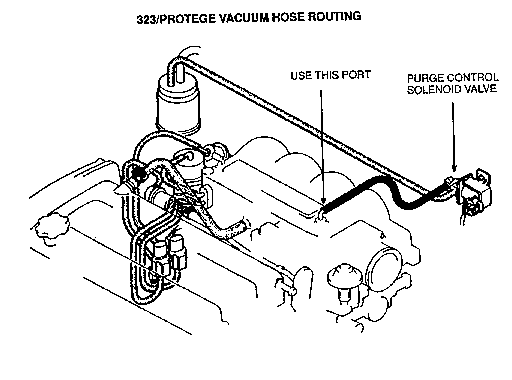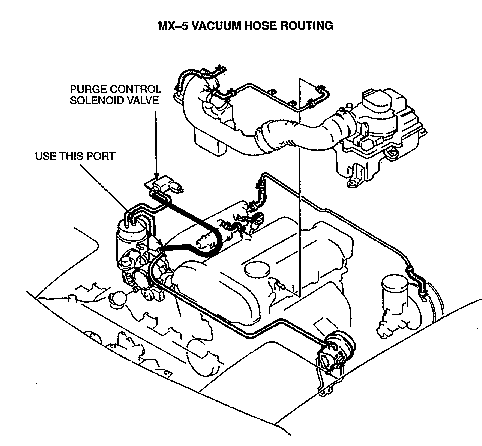Miata Technical
Service Bulletin
|
| Category |
Applicable Model(s) |
Subject |
| Bulletin No. |
004/93 |
| Issued |
6/3/93 |
| Revised |
|
|
| B |
Listed Below |
Engine noise due to carbon accumulation |
Applicable Models/Vins
1990 - 93 Protege
1992 - 93 MX-3 (V-6)
1990 - 93 MX-5
1989 - 93 B2600
1989 - 93 MPV (4 cyl.)
Description
If engine noise is heard on initial start-up and decreases
as the vehicle achieves operating temperature, carbon may
have accumulated in the combustion chamber and on the piston
tops.
NOTE: Additives in some fuels and continuous "short
trips" may contribute to carbon accumulation.
The noise that occurs is similar to Hydraulic Lash
Adjusters (HLA) noise. However, unlike HLA, the noise will
peak and decrease as the engine RMP increases. Before
beginning HLA diagnostics or replacement, perform the carbon
cleaning process described in this bulletin.
Vehicles exhibiting the above symptoms should be repaired
according to the instructions below. Inform the customer that
the noise does not contribute to engine deterioration and the
use of gas treatment to prevent carbon accumulation will
prevent reoccurrence of the noise.
Repair Information
Carbon accumulation can be removed using Mazda Top Engine
Cleaner (P/N 0000 77 2025) which is available through your
parts department. The cleaner should be induced through a
throttle body vacuum port with the vehicle idling. Diagrams
are attached to assist you in locating the correct port.
Carefully read and follow the instructions that come with
the cleaner. Recommended induction procedures are as follows:
- Operate engine to normal operating temperature then
turn engine off.
- To inject the cleaner into the engine, use the
canister purge vacuum port. This will allow even
distribution of the cleaner. Refer to pages 3 of 10
through 9 of 10 for the vacuum port locations.
CAUTION: The Mazda Top Engine
Cleaner must be fed into the engine through the correct
vacuum line and at a feed rate not less than 1.5 minutes
per half container with an orifice (P/N E5B6 13 986) in
the feeding hose. A faster feed rate may result in liquid
accumulation in a cylinder resulting in hydraulic lock-up
and engine damage.
CAUTION:
Do not use the pcv hose. Engine damage may
occur due to excessive cleaner entering the
engine.
Do not use a vehicle vacuum hose. Supply your
own feeding tube and install orifice (P/N E5B613
986).
Attach a pair of locking pliers (Vise grips)
to the feeding tube to prevent suction while the
engine is cranking.
- Place the other end of the hose in the container of
top engine cleaner.
- Restart engine.
WARNING: An excessive amount of exhaust smoke will be
produced in the next procedure. Use an exhaust hose to vent the
smoke.
- Allow idle to stabilize. Then feed the
cleaner into the engine by releasing the pliers while
idling up and down (between 1500 - 3000 rpm) a few
times until 1/2 of the cleaner is used. At this
point, let the idle drop. The engine should stall. If
it doesn't, turn engine off.
- Let the vehicle sit for at least one hour or up to 24
hours. The chemical's cleaning ability increases the
longer it is allowed to saturate the carbon.
- To flush the remaining carbon from the engine, repeat
steps 2 to 5 using the remaining 1/2 of the cleaner. DO
NOT let the engine stall. Increase the idle up
and down between 1500-2000 rpm.
- Remove your feeding tube and reconnect the original
line.
- Take the vehicle on a 3 or 4 mile performance (i.e.
full RPM range) test drive to remove any remaining
cleaner or carbon.
NOTE: After verifying the noise has been
eliminated, change the oil, oil filter and raise the engine
RPM several times to circulate new oil throughout the engine.
As a preventative measure, use a known gas treatment additive
to prevent repeat carbon accumulation (example: Chevron
Techron).


Instructions
for using Top Engine Cleaner
Back to Service Bulletins

